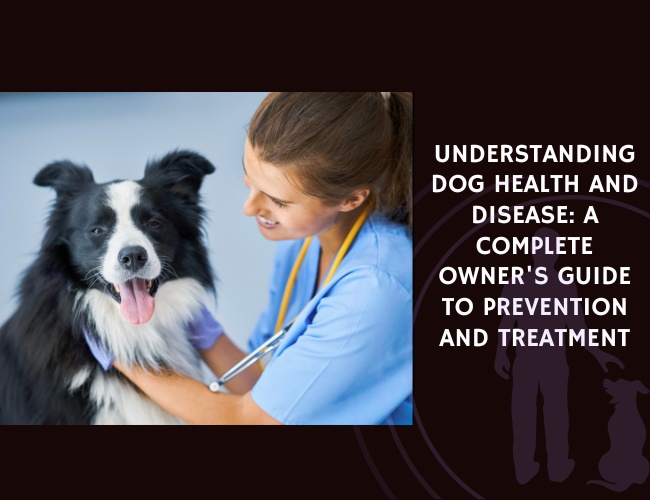Introduction to Canine Health and Disease
Why Understanding Dog Health Matters
Owning a dog brings so much joy, but also a big responsibility. We understand that every dog parent wants their four-legged friend to live a happy and healthy life. Knowing about canine health helps you notice problems early and make better choices for your pet. It means you are ready to prevent disease, support recovery, and provide the best care possible.
The Many Sides of Canine Health
A dog’s health covers many areas. Dogs can get infectious diseases, chronic issues like diabetes or arthritis, and even genetic problems that run in certain breeds. Maintaining a healthy routine—from regular checkups to parasite prevention—plays a big role in your dog’s wellbeing. Nutrition, exercise, mental stimulation, and preventive measures such as vaccines are all equally important for a thriving pup. Canine health is complex, covering not just physical but also emotional well-being [Comprehensive Study on Canine Healt.txt].
How This Guide Will Help You
This guide is here to walk you through each step of caring for your dog’s health. You might feel unsure when a new symptom appears or when choosing the right diet or treatment. We are here to assist, providing clear, reliable information sourced from recent research. With this knowledge, you will feel more confident in making decisions for your dog’s healthcare journey.
Being a prepared and informed owner is the best way to help your furry friend enjoy life to the fullest!
Common Infectious Diseases in Dogs
Understanding infectious diseases helps you protect your dog, especially those conditions spread by unwanted pests. Babesiosis and canine adenovirus type 2 are two prevalent threats in the canine world. Babesiosis is caused by parasites that infect red blood cells, often transmitted through the bite of an infected tick. Dogs may show tiredness, pale gums, or even fever. If you spot a tick on your dog, quick removal and veterinary care are very important.
Canine adenovirus type 2 primarily targets your dog’s respiratory system, potentially leading to cough, nasal discharge, or breathing trouble. This virus can spread easily through direct contact or contaminated surfaces. It is especially common in kennels and areas where many dogs mix.
Ticks, fleas, and even mosquitoes play a huge role in transmitting these diseases. Daily checks, regular bathing, and proper pest prevention are great habits for keeping your companion safe. Early detection and timely intervention give your dog the best chance at a full recovery. Staying alert to new behaviors or symptoms is one of the most helpful things you can do as a caring owner.
Chronic Conditions and Management
exploring common chronic conditions
Chronic conditions like diabetes, arthritis, and kidney disease can deeply impact your dog’s day-to-day comfort and happiness. You might notice signs such as increased thirst, changes in mobility, or unusual fatigue. We understand it can feel overwhelming when your dog faces these health hurdles. Knowing the basics about these conditions can assist you in supporting your furry companion.
- Diabetes may show up as excessive thirst, increased urination, or unexplained weight loss.
- Arthritis often leads to stiffness, difficulty standing up, or a reluctance to play and go on walks.
- Kidney disease may cause appetite loss and lethargy, especially in older dogs.
long-term management strategies
Managing chronic conditions is not just about medication. Consistent routines can make life easier for your dog:
- Feed a balanced diet tailored to the condition
- Encourage gentle exercise to maintain muscle and mobility
- Use pain management and supportive therapies when recommended
Your role includes looking for subtle changes in behavior. Early intervention and regular checkups make a big difference.
the value of consistent monitoring
Building a close partnership with your vet helps you monitor your dog’s progress. Together, you can adjust treatment plans, diet, and activity to keep your dog comfortable and thriving. With proper care and attentive observation, many dogs with chronic illnesses enjoy a good quality of life.
Staying observant and proactive forms the foundation of lifelong wellbeing for your dog.
Genetic and Breed-Specific Disorders
Understanding Hereditary Health Issues
Some health challenges dogs face are inherited and can be linked to breed. Have you ever wondered why certain breeds are more prone to hip or joint problems? Hip dysplasia stands out as a common example, especially in larger breeds. This painful condition affects the femoral joint, sometimes making it difficult for dogs to walk or play. Also, heart diseases like dilated cardiomyopathy often affect specific breeds, and short-nosed breeds face issues like brachycephalic syndrome, causing breathing troubles.
The Role of Genetic Testing and Breeding
We understand it can be worrying to learn your dog might inherit a problem. Genetic testing provides invaluable insights for owners and breeders alike. By identifying disease-causing mutations early, families can partner with veterinarians to develop healthier care plans. Responsible breeding also means selecting mates that minimize the risk of passing on common disorders, reducing their prevalence over time [Comprehensive Study on Canine Healt.txt].
Managing Breed-Specific Disorders
If your dog has or is at risk for a breed-specific disorder, there is hope. Management often includes a tailored care approach:
- Specialized nutrition for joint and heart support
- Consistent exercise routines adapted to your dog’s abilities
- Regular wellness checks with your vet
- Pain management and physical therapy options
Being proactive with genetic information can lead to a longer, happier life for your pup. Early action truly makes a big difference in your dog’s wellbeing.
Skin Conditions and Allergies
Understanding common skin issues in dogs
Many dogs experience skin troubles such as atopic dermatitis and flea allergy dermatitis. Atopic dermatitis causes itching, redness, and sometimes skin infections. Flea allergy dermatitis results from a reaction to flea saliva and can make your dog’s skin inflamed and uncomfortable. Food allergies may also play a role, often showing up as itchy skin or recurrent ear problems.
Diagnosing triggers and underlying causes
Diagnosing the trigger is key to providing relief. Your veterinarian may suggest a physical exam, reviewing your dog’s history, and sometimes skin scrapings or allergy testing. Pinpointing whether food, fleas, or environmental factors are responsible helps target the right treatment and avoid unnecessary discomfort.
Supporting your dog’s skin health
Treatment options depend on the cause. For allergic skin disease, medications like antihistamines or corticosteroids are common. Medicated shampoos, topical treatments, and flea prevention can also help. For some dogs, changing the diet or using supplements may make a big difference. Keeping your home clean and reducing allergens can assist with ongoing comfort and itch relief.
Taking action early and working with your vet helps keep your pup’s skin calm and healthy. Staying observant and responsive makes all the difference for your furry friend’s well-being.

Dental Health and Disease Prevention
understanding dental disease in dogs
We understand how much you care about your dog’s wellbeing. Maintaining dental health is an essential part of overall care, yet it often gets overlooked. Did you know that periodontal disease is one of the most common health issues in dogs? In fact, it affects up to 80 percent of dogs aged three and over. This condition, along with gingivitis and tooth root abscesses, can cause pain, bad breath, and even tooth loss if left untreated. Gum inflammation starts with bacteria buildup and can progress quickly without proper care.
preventive dental care habits
The good news is most dental disease is preventable! Brushing your dog’s teeth regularly remains the most effective way to reduce risk, potentially lowering dental disease rates by up to 70 percent. You can also help by using dental chews or toys designed to clean teeth and gums. Regular checkups with your veterinarian are crucial for early detection of dental problems, as some issues are hidden beneath the gum line.
dental health and overall wellness
Oral health is deeply connected to your dog’s overall wellbeing. When infections in the mouth are left untreated, harmful bacteria can enter the bloodstream. This can affect the heart, liver, and kidneys over time. You might feel surprised that such a small area—your dog’s mouth—can have such a big impact, but taking simple steps to support dental health helps keep your pup happy and healthy for years to come.
Regular preventive care ensures your dog enjoys an active, comfortable life.
Cancer in Dogs: Detection and Treatment
Common Types and Warning Signs
Cancer is one of the leading health concerns for dogs. While any dog can develop cancer, age and genetics can play a role. Some common cancers in dogs include lymphoma, mast cell tumors, and osteosarcoma. Spotting cancer early can make a significant difference in your dog’s treatment options and outcomes. Warning signs might include:
- Unusual lumps or swellings that grow over time
- Sudden weight loss or ongoing loss of appetite
- Sores that do not heal
- Bleeding or discharge from any body opening
- Difficulty breathing, urinating, or defecating
Remember, some symptoms may be subtle at first. Reach out to your veterinarian if you notice any changes in your dog’s normal behavior or appearance.
Diagnostic Approaches and Importance of Early Detection
Veterinarians use several tools to diagnose cancer. These may include blood tests, X-rays, ultrasounds, and biopsies. Advanced diagnostics, like genetic testing, are becoming more common and can help catch certain cancers earlier. Early detection is key, as it allows more treatment choices and often leads to better results [Comprehensive Study on Canine Healt.txt].
Treatment Choices: Traditional and Emerging Therapies
Cancer treatment for dogs has advanced a lot. The most common options include:
- Surgery to remove tumors
- Chemotherapy and radiation to target cancer cells
- Pain management and supportive care
Some veterinarians now use complementary therapies, such as holistic nutrition or physical therapy, to support dogs during treatment. Each treatment plan is unique, tailored to your dog’s health and the cancer type.
Staying alert to symptoms and working closely with your veterinarian can help you make the best choices for your dog’s care.
Preventive Care Essentials
Vaccinations and Their Benefits
Keeping your dog healthy starts with strong preventive care. Vaccination is one of the best tools you have to protect your furry friend against infectious diseases. Vaccines help your dog build immunity to threats like rabies and parvovirus, often before they’re exposed in the real world. Responsible pet owners understand that following vaccination schedules isn’t just about rules—it’s about making sure your dog lives a long, happy life.
Parasite Prevention Strategies
Tiny foes like fleas, ticks, and heartworms can impact your dog’s comfort and well-being. Using vet-recommended parasite preventatives will shield your buddy from itchiness, anemia, or even deadly heartworm disease. Offer regular, monthly treatments and check for ticks after walks. Quick action can truly make a difference!
Value of Regular Veterinary Checkups
Routine wellness visits help you catch problems early. Have you ever noticed a change in your dog but weren’t sure if it was serious? Regular vet exams bring peace of mind, allowing early detection of illness when it’s most treatable. Your vet can guide you on nutrition, behavior, and tailored prevention—helping you make confident, informed choices for your companion’s care.
By focusing on these simple yet critical steps, you help set the stage for a healthier future for your pup.
🐾 Healthy. Happy. Dog.
From Noticing to Knowing:
Health starts long before the vet visit. Whether it’s a new lump, a shift in behavior, or a subtle change in appetite—your awareness is your dog’s first line of defense. Early detection, daily routines, and smart prevention turn you from a pet owner into a true health advocate.



Knowledge Saves Lives:
From parasites to dental care, genetics to joint health—canine wellness is complex but manageable. This guide gives you real, research-backed insights and simple tools to act with confidence. Because staying informed isn’t just helpful—it can make all the difference in giving your dog a longer, healthier life.
Nutrition and Exercise for Optimal Health
Fueling Your Dog’s Immune System
We understand that you want your dog to live a long and healthy life. Have you ever wondered why some dogs rarely get sick while others seem prone to infection? Much of this comes down to proper nutrition. The right blend of proteins, fats, vitamins, and minerals helps support your dog’s immune function. A well-fed immune system is better at fighting off common illnesses and chronic diseases. Dogs with balanced diets often recover faster and have shinier coats—a visible sign of internal health.
Exercise: More Than Just Walks
Exercise isn’t only for burning energy. Consistent physical activity helps prevent obesity, keeps joints flexible, and improves mood. Dogs who get regular exercise are less likely to suffer from anxiety or destructive behaviors. You might feel reluctant to go for that extra walk, but remember—your dog’s heart, muscles, and mind benefit each time you do.
Tailored Plans for Unique Needs
Every dog is an individual. Factors like age, breed, and health status matter when planning meals or exercise routines. Puppies need more calories and frequent play; seniors may require softer foods and gentler walks. Pay attention to any changes in weight or behavior, and partner with your veterinarian to adjust care as your dog ages.
By understanding your dog’s nutritional and exercise needs, you can set the stage for lifelong wellness.
Diagnostic Techniques and Testing
Understanding the right diagnostic tools can make all the difference when your dog is not feeling well. Veterinarians use several methods to help pinpoint what might be wrong and guide treatment decisions. This chapter explores these techniques so you can feel more at ease during vet visits 🩺.
Common Veterinary Diagnostic Tools
Everyday tools play a major role in detecting illness early:
- Blood tests check for infections, organ function, and certain chronic diseases.
- Imaging techniques—such as X-rays and ultrasounds—help spot bone injuries, tumors, or internal issues.
- Biopsies involve taking a small tissue sample to look for cancer or other diseases under a microscope.
These tools work together to provide a clearer picture of your dog’s health.
Emerging Technologies
Genetic testing is gaining popularity, especially when doctors suspect inherited conditions like hip dysplasia. Technology is evolving, too—wearable health monitors and artificial intelligence (AI)-assisted tools are beginning to assist with real-time health tracking and faster diagnoses [Comprehensive Study on Canine Healt.txt].
Easing the Diagnostic Process
It is normal to feel anxious if your dog needs a test. Most procedures are safe and quick, and your veterinary team will guide you through each step. For best results, keep your dog calm, follow fasting instructions if given, and bring their favorite toy or blanket for comfort.
Staying informed about these tools helps you make the best choices for your dog’s care journey.
Treatment Approaches and Therapies
When it comes to helping your dog feel better, a variety of treatment options are available. Conventional approaches include medications like antibiotics for infections and non-steroidal anti-inflammatory drugs (NSAIDs) for pain. In some cases, surgery may be recommended for conditions such as broken bones or cancer. Chemotherapy has also become an option for managing certain cancers in dogs.
Supportive therapies are growing in popularity and can make a real difference in your dog’s quality of life. Pain management is essential, especially for older dogs or those with chronic illnesses. Therapies like physical therapy, acupuncture, and hydrotherapy are gentle ways to help your furry friend regain strength, reduce discomfort, and move more easily.
Holistic and integrative veterinary medicine is becoming more common. This can include using nutraceuticals, herbal medicine, and even special diets to supplement your dog’s treatment plan. Some owners turn to these methods to support conventional treatments or when they seek a more natural approach, though it is important to consult your veterinarian first.
Each dog is unique, so treatment plans should be tailored for their individual needs. Working closely with your vet ensures your furry companion gets the best possible care as they face new challenges ahead.
Rehabilitation and Recovery
Supporting Healing After Surgery or Injury
We understand that seeing your dog recover from surgery or injury can be stressful. Post-operative care is vital for a smooth recovery. Keep your dog’s environment calm and comfortable. Limit their movement as advised by your veterinarian and provide a cozy resting spot. Follow any specific medication or feeding instructions carefully. Use an Elizabethan collar or similar device if needed to prevent licking or biting wounds.
Rehabilitation Strategies for Chronic Conditions
Has your dog faced an injury or chronic condition like arthritis? Rehabilitation options such as physical therapy, pain management, hydrotherapy, or acupuncture can make a big difference. Simple, consistent exercises—like gentle leash walks or supervised swimming—help improve mobility and decrease discomfort. Regular check-ins with your veterinary team ensure your pet’s plan stays effective.
Creating a Supportive Home Environment
A peaceful home helps your dog recover both physically and emotionally. Keep them away from slippery floors, and use ramps instead of stairs when possible. Offer soft bedding and keep their essentials—food, water, medicines—nearby. Shower your companion with gentle affection and encouragement. These small steps can build confidence and speed up healing.
Caring for your dog’s recovery not only helps them heal but strengthens your bond along the way.
Recognizing Signs of Illness
Behavioral indicators to watch for
We understand you know your dog’s unique personality better than anyone. Often, changes in behavior are the first clue that something might be wrong. You might notice your dog suddenly becomes less playful, refuses favorite treats, or avoids family members. Dogs can also become restless, hide, or display more aggression or anxiety than usual. Unexpected accidents in the house or a change in sleeping patterns can also signal an underlying health issue. If you ever wonder “Is my dog acting odd?” trust your instincts—these changes may be your dog’s way of asking for help.
Physical symptoms that need prompt attention
Physical symptoms can appear alongside or without behavioral changes. Be alert for warning signs such as vomiting, diarrhea, trouble breathing, coughing, limping, or repeated scratching. Sudden weight loss, a bloated abdomen, excessive drinking, or bleeding from any part of the body require immediate veterinary attention. Persistent bad breath, unusual lumps, or difficulty standing up can also signal diseases like cancer or metabolic issues. Always remember, early action leads to better outcomes.
Normal variations versus concerning changes
Every dog is unique—some may sleep more, shed seasonally, or be naturally picky eaters. The key is to recognize shifts from your dog’s usual habits. Rapid or ongoing changes in mood, appetite, or energy are worth discussing with your veterinarian. Not every difference means something serious, but erring on the side of caution helps protect your dog’s health and happiness.
Staying observant empowers you to advocate for your dog, ensuring timely care and peace of mind.
The Financial Aspects of Veterinary Care
Understanding Routine and Emergency Care Costs
We understand that thinking about your dog’s health often brings financial questions. Routine veterinary care, like vaccinations, wellness exams, and parasite prevention, may cost anywhere from $50-$300 per visit. However, unexpected emergencies—such as broken bones or sudden illnesses—can quickly raise bills to $500-$2,000 or more. These costs can be challenging, especially if they occur without warning.
The Value of Preventive Care
Have you ever wondered why veterinarians always stress preventive care? Regular checkups, vaccines, and early diagnostics might feel like extra expenses, but they can actually help you save money in the long run. Catching disease early often means less expensive treatments and better outcomes for your dog [Comprehensive Study on Canine Healt.txt]. For example, investing in annual dental cleanings can prevent costly oral surgeries in the future.
Managing Veterinary Expenses
You might feel overwhelmed when facing a vet bill, but there are options to help you manage costs:
- Pet insurance can cover a portion of unexpected treatments. Plans typically range from $20-$70 per month depending on your dog’s age and health.
- Many clinics offer payment plans, allowing you to split larger bills into smaller, manageable payments.
- Setting aside a monthly savings amount for pet health emergencies can also provide peace of mind.
As you continue to guide your dog’s wellbeing, understanding the financial side of care will help you feel prepared and empowered.
Working Effectively with Your Veterinarian
Building a productive partnership
We understand how important it is to feel confident in your dog’s care team. A positive, respectful relationship with your veterinary healthcare team makes decision-making easier and less stressful. Share insights about your dog’s personality, habits, and recent changes—these small details can help guide care. Ask questions, express your concerns, and listen to recommendations. Teamwork is key in keeping your dog healthier and happier.
Preparing for veterinary visits
Veterinary visits are more effective when you are prepared. Before your appointment, make a list of questions or concerns, and note any changes in your dog’s behavior, appetite, or activity. Bring a record of their diet, medications, and recent health issues. Arriving calm and organized can help your dog feel at ease, too. Remember, being proactive helps your vet identify concerns sooner.
The importance of treatment compliance and follow-up care
Following your veterinarian’s instructions closely is crucial for your dog’s recovery or ongoing comfort. Treatment compliance—taking medications as prescribed, attending scheduled follow-ups, and monitoring symptoms—gives your dog the best chance for success. If you encounter challenges or notice new symptoms, reach out right away. Your diligence and communication can make a world of difference in your dog’s health journey.
With shared effort and good communication, you and your veterinarian can provide your dog with excellent care throughout life.
Future Directions in Canine Healthcare
Pioneering Technologies and Treatments
Exciting advances are shaping the future of health care for dogs. Veterinary medicine now uses tools once seen only in human hospitals. Blood tests, imaging techniques, and even AI-assisted diagnostics are becoming more common. Wearable health monitors help track your dog’s activity, heart rate, and sleep, making it easier to notice changes early and get help fast.
Veterinarians are also exploring new therapies. Medications, surgery, and stem cell therapy are being refined for better outcomes. Complementary treatments such as physical therapy, acupuncture, and tailored nutrition add extra layers of care, focusing on your pup’s comfort and recovery.
Genetics and Personalized Care
Genetic testing is revolutionizing how we care for our dogs. These tests are invaluable for identifying breed-specific risks like hip dysplasia or heart issues. By understanding a dog’s genetic makeup, you and your vet can work together on personalized prevention plans, or make more informed choices when selecting a pup or planning a breeding program.
Lessons from Human Medicine
Veterinary science has long borrowed ideas from human medicine. From advanced imaging machines to dietary therapies and behavior support, breakthroughs for people often help dogs, too. As research deepens, we’ll see even more of these life-improving tools in veterinary clinics.
Dog owners play a crucial role by staying informed and working alongside their vets with curiosity and care. Your engagement ensures your furry companion receives the best that modern veterinary medicine offers.
Conclusion: Your Role in Your Dog’s Health Journey
Stepping Up With Preventive Care
Responsible dog owners play the most important role in keeping canine companions healthy. Practicing preventive care is key. This means sticking to regular vaccinations, ensuring parasite protection, providing high-quality nutrition, and keeping up with routine vet visits. Exercise and mental stimulation help keep dogs happy and avoid many health issues. Simple habits—like brushing teeth and monitoring weight—can also make a big difference.
Attentiveness: The First Line of Defense
Being observant is your secret superpower. You might notice changes in energy, appetite, or behavior before anyone else. Early action when something feels off allows for quicker veterinary intervention, often resulting in better outcomes. Consistently checking for physical signs, such as lumps, skin changes, or limping, helps catch problems before they become serious.
Continual Learning for Lasting Wellbeing
Staying informed empowers you to guide your dog’s care confidently. Trusted resources include veterinary clinics, reputable online platforms, and educational books. Developing a habit of ongoing learning helps you stay ahead of emerging health risks and best practices. Remember, every dog is unique, and your commitment keeps their tail wagging for years to come.










